Dragon in Chanoyu
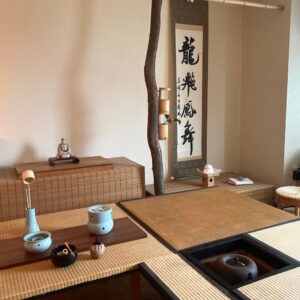
Pictured above are:
Kake hana-ire, 掛花入, hang flower-receptacle, bamboo ni-jū-giri, 二重切, two-tier-cut; L. 15 sun kane-jaku, by David Flanagan, Jamaica Plain, Mass. Kō-gō, 香合, incense-gather, porcelain, design of ryū-hō, 龍鳳, dragon-‘phoenix’; diam. 2.1 sun kane-jaku: China, displayed on pack of folded paper, kami-kama-shiki, 紙釜敷, paper-kettle-spread. Kagami mochi, 鏡餅, mirror-mochi, on wooden san–bō, 三宝, three-treasures, H. 5 sun kane-jaku.
Ro, 炉, hearth: ‘kashiwa-de gama’, 柏手釜, oak-hand kettle, by Taka-hashi Kei-ten, 高橋敬典, High-bridge Respect-law, Nin-gen Koku-hō, 人間国宝, Person-interval Country-treasure, Yama-gata, 山形, Mountain-form.
Kai-gu, 皆具, all-tools; tobi sei-ji, 飛青磁, fly blue-porcelain, mizusashi, shakutate, hibashi, hishaku, kensui, futaoki, by Ishi-zaki Hide-haru, 石崎英治, Stone-cape Splendor-peace, Yo-kka-ichi, 四日市, Four-day-city.
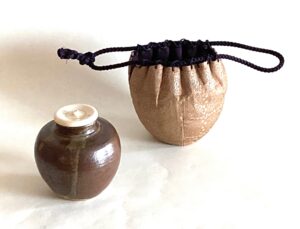
Cha-ire, 茶入, tea-receptacle, ceramic ‘maru-tsubo’, 丸壺, round-jar, with brown glaze, by Richard Milgrim, Kyōto. Silk shi-fuku, 仕覆, serve-cover, with pattern of kaku-ryū kin-ran, 角龍金襴, corner-dragon gold-brocade.
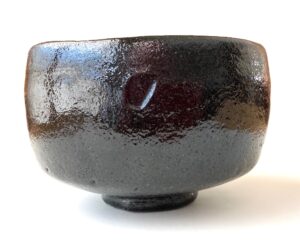
Cha-wan, 茶碗, tea-bowl, ceramic with black glaze ‘raku’, 楽, pleasure; diam. 4 sun kane-jaku, by Henry Mittwer, abbot of Ten-ryū-ji, 天龍寺, Heaven-dragon-temple, Kyōto.
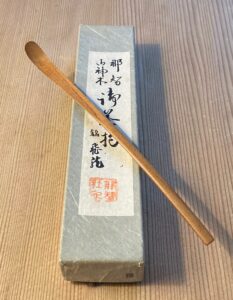
Cha-shaku, 茶杓, tea-scoop, sacred keyaki, 欅, zelkova, wood from Kuma-no Hon-gū Tai-sha, 熊野本宮大社, Bear-field Origin-palace Great-shrine, named ‘Hi-ryū’, 飛龍, Flying-dragon, after the sacred waterfall at the shrine; L. 6.2 sun kane-jaku. With paper box from shrine.
There are several Kanji for dragon, The most formal Kanji is 龍, which in Japanese is read tatsu, ryū, ryō, etc. This Kanji is the foundation of 竜 which generally refers to a Chinese dragon. When the Chinese language simplified their Hanzi character 龍 was changed to 龙. The Chinese reading for ‘dragon’ includes loong, long, and lung. The zodiac sign of the dragon is 辰.
Pairing the dragon and phoenix is extremely popular in China, not only in philosophy and poetry, but also in cuisine. Numerous Chinese restaurants worldwide list on the menu a dish combining shrimp and chicken, earthly representatives of the dragon and phoenix. In China, the dragon is the king of the oceans, and phoenix is the queen of all birds.
The word ‘phoenix’ can be misleading, as the bird called a phoenix may be inspired by an actual bird, such as a pheasant or parrot. The Chinese ‘phoenix’ is called a hō, 鳳, which is a male bird, and is paired with a female ‘phoenix’, ō, 凰. There is another Chinese ‘phoenix’ called a hō, 鵬, that is part of the name of Hō-un-sai, 鵬雲斎, ‘Phoenix’-cloud-abstain, XV Iemoto, Urasenke. The phoenix known in the west originated in Persia, which was a mythical bird that lived for hundreds of years, was consumed by fire, and rose reborn from the ashes. The etymology of ‘phoenix’ means the color red-purple. In Egypt, it is identified with the date palm, ostensibly because the fronds look like feathers.

Kake-mono, 掛物, hang-thing, ‘Ryū-hi Hō-bu’, 龍飛鳳舞, Dragon-leap ‘phoenix’-dance; signed in Chinese Hànzi, Qi-lin, 桂林, Katsura-woods, read in Japanese, Kei-rin. L. 6.8 kane-shaku. China.
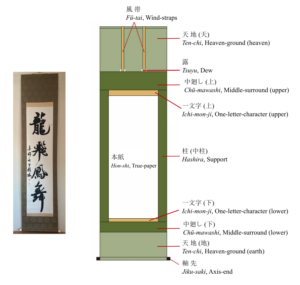
The kakemono was created in China, and the diagram drawing of the kakemono and its parts is of the basic Japanese kakemono. Elements of the hanging scroll, hyō-gu, 表具, front-tool, are typical of Chinese mounting of simple hanging scrolls. Compared to Japanese scroll mountings, this Chinese scroll lacks the top and bottom sections identified with ten, 天, heaven, and chi, 地 and earth. It is as though they were removed from the scroll, leaving the chū-mawashi, 中廻し, middle-surround, and the upper and lower ichi-mon-ji, 一文字, one-letter-character, bands at the top and bottom of the hon-shi, 本紙, true-paper.
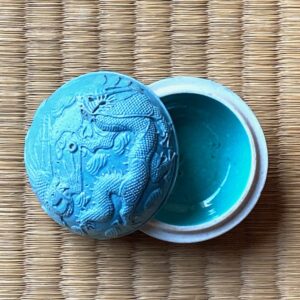
Kō-gō, 香合, incense-gather, round, porcelain, covered container with relief design of ryū-hō, 龍鳳, dragon-‘phoenix’, blue glazed exterior, and greenish-blue glazed interior, unmarked; diam. 2.1 sun kane-jaku: China.
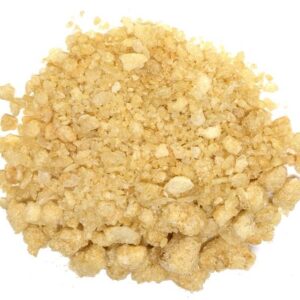
One of the ingredients in neri-kō, 練香, knead-incense, used with the ro, is ryū-no, 龍脳, dragon-brain, camphor heartwood. Such incense may be included in neri-kō, 練香, kneaded-incense, which is used in the ro.
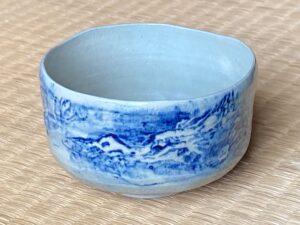
Cha-wan, 茶碗, tea-bowl, thin, ceramic bowl with blue glaze design of a dragon’s head, marked san-jū-ichi tatsu-mi Tai-hei, 三十一辰巳 太平, three-ten-one dragon-snake grand-peace; diam. 2.2 sun kane-jaku.
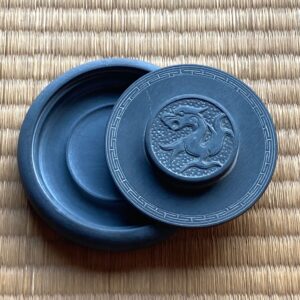
Suzuri, 硯, inkstone, round, covered container made of black stone, with design of a dragon-like creature, the edge with a frieze of kaminari, 雷, lightning; diam. 3.3 sun kane-jaku. China.
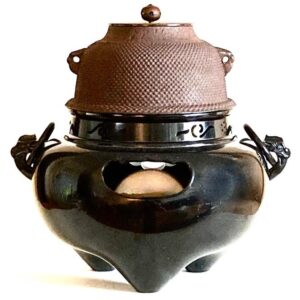
Ki-men-bu-ro, 鬼面風炉, Demon-face-wind-hearth, with loose kan, 釻, metal rings, held in lugs, kan-tsuki, 鐶付, metal ring-attach, in the form of demon-masks; Kara-kane, 唐銅, Tang-copper, bronze, with kama, 釜, kettle, tetsu, 鉄, iron, with futa, 蓋, lid, and tsumami, 摘み, pinch, knob; by Kana-mori Jō-ei, 金森浄栄, Gold-woods Pure-splendor, Taka-oka, 高岡, High-hill.
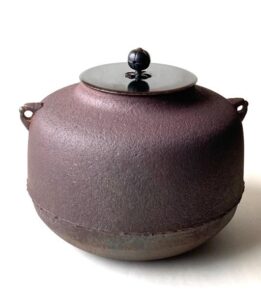
Ro gama, 炉釜, hearth kettle, A-mi-da-dō gama, 阿弥陀堂釜, Praise-increasingly-steep-hall kettle: tetsu, 鉄, iron, with rounded shoulder and brown patination, with blackened Kara-kane buta, 唐銅蓋, Tang-copper [bronze] lid, with ume tsumami, 梅摘み, apricot pinch, knob; 7.3 x 9 sun kane-jaku [ratio 8:10], by Kiku-chi Masa-toyo, 菊地政豊, Chrysanthemum-ground Govern-excellent, (actual name Masa–mitsu, 政光, Govern-light), Yama-gata, 山形, Mountain-form; Rikyū konomi, 利休好, Rikyū choice.
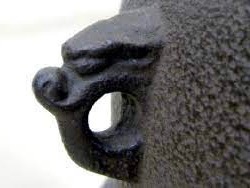
Kan-tsuki, 鐶付, metal ring-attach; one of a pair of iron lugs on a kama, 釜, kettle, for the ro, 炉, hearth, in the form of a dragon head, ryū-tō, 龍頭, dragon-head, familiarly called a ki-men, 鬼面, demon-face. The kama is moved using detachable kan, 鐶, metal rings.
The kantsuki on most kama are in the form of kimen. Pairs of ‘dragons’ vie to get the hō-ju, 宝珠, treasure-jewel, and are often depicted on metal kane, 鐘, bells. As shown in the photograph of the kimen buro, the hōju may be represented by the tsumami, 摘み, pinch, knob on the lid of the kettle.
Dragons are prevalent in Chanoyu, and the ki-men–bu-ro, 鬼面風炉, is a start, because the furo has dragon head-like lugs called kan-tsuki, 鐶付, metal ring-attach. These lugs are on most kama, 釜, kettles. It is likely that these faces are not actually demons, but sons of the Dragon King. There are nine sons, Ryū-sei-kyū-shi, 竜王九子, Dragon-born-nine-child, and one of them has a ring in its mouth, and it is he who is often seen on doors to make them secure.
The furo is a kind of housing, and may be symbolic of the Burning House parable from Buddhism. The Three Wheel Fires, the qualities of greed anger and ignorance which cause suffering, may be easily identified with the three pieces of charcoal of the shita-bi, 下火, down-fire.
When building the charcoal fire using the hai-ki, 灰器, the hai-saji, 灰匙, ash-spoon, is used to remove some ash from the front face of the ash bed, and deposit it at the back of the furo. Moving the ash might evoke dividing into eight parts the ashes from Buddha’s cremation fire. When building the fire in the ro, in certain presentations, eight scoops are ash are spooned around the fire, and three scoops are put between the prongs of the gotoku.
The Japanese dragon has 117 scales; 36 In/Yin scales and 81 Yō/Yang scales. Gautama attained Enlightenment at the age of 36, and became the Buddha. He lived until he was 80 years old, and then attained Nehan, 涅槃, Nirvana. The dragon’s 81 Yō/Yang scales may be symbolic of the attributes of the Buddha, which includes one scale that is identified with Nehan. Maybe the small amount of ash that we move from the front to the back of the furo is that scale of Nehan, demonstrating the Buddha’s transformation and ultimate achievement.
Incense is an essential aspect of building the charcoal fire for Chanoyu. Byakudan, 白檀, white-sandalwood, is used in the furo fire, and neri-kō, 練香, knead-incense, in the ro fire. It is believed that the breath of a dragon is like incense, and is called ryū-no-iki, 龍の息, dragon-’s-breath. The dragon’s saliva, also, can produce fragrances of all kinds. A dragon’s breath becomes clouds that provide a place so that dragons can hide and create rain or lightning. Lightning is the equivalent of, and causes fires.
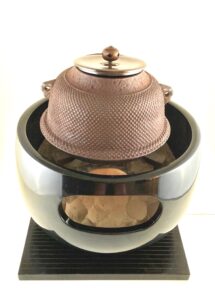
For a formal Tea presentation, Rikyū’s mayu–bu-ro, 眉風炉, Eyebrow-wind-hearth, has an ash bed that is covered with uroko–bai, 鱗灰, scale-ash. Regular wood ash is made wet and spooned in small amounts onto the surface of the ash, and are likened to uroko, scales. The Japanese dragon has features taken from various animals, one of which is scales that are like scales of a koi, 鯉, carp. So, the uroko ash indicates that the furo may have something to do with dragons.
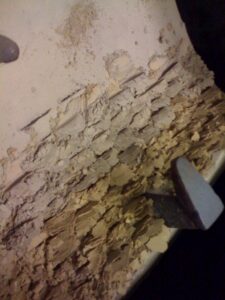
The ash bed of a furo with a pattern of the uroko-bai. 鱗灰, scale-ash.
The ash in the furo ideally is ki-shoku bai, 黄色灰, yellow-color ash. The yellow color comes from the ash being stored in old sake barrels, saka-daru, 酒樽, sake-barrel. A typical sake barrel is made of Yoshi-no sugi, 吉野杉, Luck-field cedar.
The Yellow Dragon is symbolic of the Center, and of earth. The EarthDragon cleans the rivers and deepens the oceans, and as such it is believed to offer protection from fire.
According to Chinese and Japanese lore, there are five dragons, and they reign in the four directions and the center:
East, Higashi – Sei-ryū, 青龍, Blue/green-dragon.
South, Minami – Seki–ryū, 赤龍, Red-dragon.
West, Nishi – Haku-ryū, 白龍, White-dragon.
North, Kita – Hoku-ryū, 北龍, Black-dragon.
Center, Naka – Kō-ryū, 黄龍, yellow-dragon.
The mayu-buro requires a go-toku, 五徳, five-virtues, trivet, which as three prongs to support the kama. Japanese dragons have three tsume, 爪, talons, that hold the hō-ju, 宝珠, treasure-jewel: san-pon no ryū, 三本の龍, three-origins ’s dragon.
There are many types of dragons, particularly in China, and they are in part categorized by the number of talons. Five talons is for the emperor. Dragons with three talons are often identified as being Japanese dragons. The following is a quote from the Illustrated Encyclopedia of Japanese Unidentified Creatures:
鬼などの妖怪が三本指のため、妖怪視された近世の龍は三本の指であり、これが一般的となった.
Oni nado no yō-kai ga san-bon yubi no tame, yō-kai-shi sa re ta kin-sei no ryū wa san-bon no yubi de ari, kore ga ip-pan-teki to natta.
“Since monsters such as demons have three fingers, dragons considered to be monsters have three fingers and this has become common.”
The hōju may be identified with the kama, which suggests that hot water, yu, 湯, is symbolic of combined In and Yō, which the hōju embodies. The Kanji for yu, 湯, is composed of Kanji for water, mizu, 水, and sun, nichi, 日, and moon, tsuki, 月, kō-ryū, 黄龍, yellow-dragon,りゅ which is somewhat similar to Rikyū’s name Sō-eki, 宗易, Sect-change.
It is believed that dragons are afraid of iron. Ka-ji-ya, 鍛冶屋, Forge-smelt-house, blacksmithy: metal workers revere Rai-jin, 雷神, Thunder-god who accompanies rain, clouds, lightning, which are all related to dragons. Those who suppress inundations use iron, dragon claw iron gotoku, and water filled iron kama.
Ryū-zu, 竜頭, dragon-head, the dragon-shaped handle at the top of the bell, by which it is carried or hung. Among the variations of dragon lug on the bell, the pictured example shows two dragons with their mouths open and joined to the bell, as though producing the sounds of the bell. The lug is crowned with the hō-ju, 宝珠, treasure-jewel. On New Year’s Eve, the bon-shō, 梵鐘, temple-bell, is struck 108 times, to help dispel unwholesome desires.
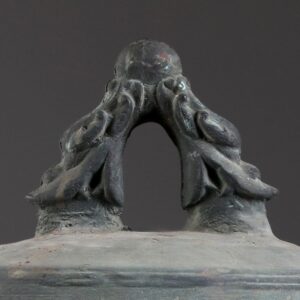
In Chanoyu, a smaller version of the temple bell is the kan-shō, 喚鐘, call-bell, is struck to summon guests back into the Tearoom to have Tea. This call bell also has its origins in Buddhism.
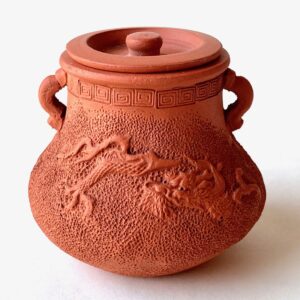
Cha-ki, 茶器, tea-container; terra-cotta, lidded, baluster-form jar with design of a dragon, Shu-dei-ryū-maki, 朱泥龍巻, vermilion-mud dragon-wrap, Toko-name-yaki, 常滑焼, Ever-slip-fired, H. 2.4 sun kane-jaku. [without lid, 1.8 sun kujira-jaku]. The frieze motif near the rim is highly stylized lightning, kami-nari, 雷. Dragons bring rain, thunder, and lightning. The natural red-orange color of terra cotta, may be likened to the seki-ryū, 赤龍, red dragon, of the south.
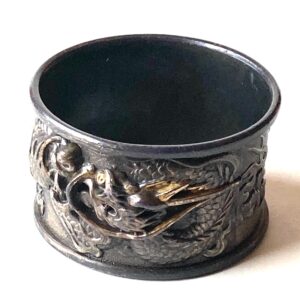
Napkin ring used as a futa-oki, 蓋置, lid-place, to rest the lid of a kama, 釜, kettle. The dark patinated metal [bronze?] ring has a relief design of a dragon, tatsu, 龍, with gold wash details. H. one sun kane-jaku. Un-marked.
With the adoption of western culture, Japan was inspired to create objects that were alien to their own traditions, such as napkin rings, but bearing traditional Japanese motifs.
When the making and wearing of swords was prohibited by the government, metal artisans made a great variety of metal objects including sculpture, often with extraordinary intricacies. The pictured napkin ring was created in a multi-panel mold.
Dragons are associated with lightning both in motifs and in mythology. The Kanji Shin, 震, Shake, which is also the Hanxi character, zhen, thunder, contains the kanji for dragon; this Kanji is also the name of the trigram ☳ for east, and is the location of the chaire on the ha-kke bon, 八卦盆, eight-sign tray. Often with thunder comes lightening. From a scientific perspective, lightning bursts that occur all around the Earth create electromagnetic waves that circle around the globe within the realm of the ionosphere. When these pulses align, the wavelengths increase in strength and create what some call the Earth’s atmospheric ‘heartbeat’, also known as the Schuman resonance.
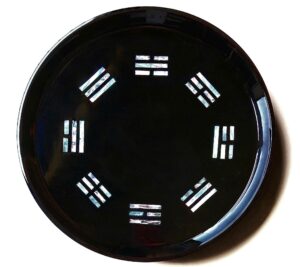
Ha-kke bon, 八卦盆, Eight-signs tray; black-lacquered wooden tray with the eight trigrams of the Eki-kyō, 易経, Change-sutra, in ao-gai, 青貝, blue-shell, mother-of-pearl.
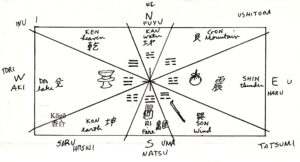
Diagram showing the ten-ita, of the take dai-su, with the trigrams of the hakke bon, and identifying the nature of the chadōgu that is displayed on the tray. Included are the twelve zodiac names, and directions.
The Ekikyō, also known as the Book of Changes or I Ching, establishes various orientations of Chanoyu and Asian culture. It is essential in the orientation of the tearoom and the placement of utensils, as well as the definingnature of each of the Tea utensils. The circle of the Ha-kke, 八卦, Eight-signs, establishes the center of the world, and for Tea people, the yojōhan is the center of the world.
In the Eki-kyō there are ha-kke, 八卦, eight-[divination] signs, called trigrams because they are composed of three lines. These eight signs are identified with primal aspects of nature. There are two kinds of lines. One is solid, which is identified as Yō, 陽, Positive, and one broken or with two parts, that is identified as In, 陰, Negative. With trigrams, there are eight different combinations of In and Yō lines. In the Ekikyō, two trigrams are combined to form sixty-four hexagrams.
Dragon is mentioned throughout the Ekikyō commentary, starting with the very first hexagram, ䷀, Ken, 乾, Heaven. Hexagrams, and the trigrams from which they are derived, are read from bottom to top. The first hexagram Ken, is made of six unbroken lines. In this hexagram, each of the six lines, if created with the number 9, refers to a dragon. The number 9 is a moving line. When all six lines are created by the number 9, this means the hexagram is in motion and it often refers to good fortune.
For further study, see also: Anatomy of Japanese Tea Ceremony: Lecture 3 The Five Elements and the Ekikyō, Unryū Gamma, and search Dragon

